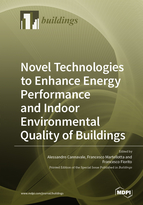Novel Technologies to Enhance Energy Performance and Indoor Environmental Quality of Buildings
A special issue of Buildings (ISSN 2075-5309). This special issue belongs to the section "Building Energy, Physics, Environment, and Systems".
Deadline for manuscript submissions: closed (31 May 2021) | Viewed by 52554
Special Issue Editors
2. National Research Council, Institute of Nanotechnology (CNR-NANOTEC), Via Monteroni, 73100 Lecce, Italy
Interests: building integration of innovative technologies; energy saving; building energy
Special Issues, Collections and Topics in MDPI journals
Interests: hermal comfort; indoor environment quality; architectural acoustics; building simulation; energy saving and renewable energies
Special Issues, Collections and Topics in MDPI journals
Interests: facade engineering and design; building construction technologies; energy savings in buildings; local and global climate change and buildings
Special Issue Information
Dear Colleagues,
This Special Issue aims at reporting current investigations on emerging materials and devices taking up the challenge of pursuing a significant improvement in the energy performance of buildings and indoor comfort. What is the contribution of innovative technologies in the epochal transition to low environmental impact buildings? This is the question to be answered with this Special Issue of the Buildings journal, in order to offer a wide and heterogeneous amount of data to readers and results of high scientific impact concerning the application of innovative technologies in construction.
The 2015 Paris Agreement on climate change following the COP 21 Conference on Climate Change, organized by United Nations, required the States to reduce carbon emissions in the building stock. In the European Union, almost 50% of final energy consumption is used for heating and cooling; out of this huge amount, 80% is used in buildings. It makes sense, then, that the Union’s goals are inherently linked to the real effort to renovate the building stock. To do this, in the EU and worldwide, the priority is to enhance energy efficiency, by deploying low-cost renewable energies and innovative technologies, especially deriving from recent achievements in the field of nanomaterials research, with special reference to building integration of novel technologies, spanning from chromogenics to semitransparent photovoltaics, superinsulating materials, and phase change materials. Articles may therefore deal with every construction or plant component of the building organism, taking advantage of novel technologies to improve their performance, from the envelope to structures, HVAC, and other technical systems, as well as indoor climate analyses in buildings and indoor environmental quality (IEQ), as well as visual comfort indoor. Studies concerning nearly zero energy buildings (NZEB) are especially welcome in this issue.
Dr. Alessandro Cannavale
Prof. Francesco Martellotta
Dr. Francesco Fiorito
Guest Editors
Manuscript Submission Information
Manuscripts should be submitted online at www.mdpi.com by registering and logging in to this website. Once you are registered, click here to go to the submission form. Manuscripts can be submitted until the deadline. All submissions that pass pre-check are peer-reviewed. Accepted papers will be published continuously in the journal (as soon as accepted) and will be listed together on the special issue website. Research articles, review articles as well as short communications are invited. For planned papers, a title and short abstract (about 100 words) can be sent to the Editorial Office for announcement on this website.
Submitted manuscripts should not have been published previously, nor be under consideration for publication elsewhere (except conference proceedings papers). All manuscripts are thoroughly refereed through a single-blind peer-review process. A guide for authors and other relevant information for submission of manuscripts is available on the Instructions for Authors page. Buildings is an international peer-reviewed open access monthly journal published by MDPI.
Please visit the Instructions for Authors page before submitting a manuscript. The Article Processing Charge (APC) for publication in this open access journal is 2600 CHF (Swiss Francs). Submitted papers should be well formatted and use good English. Authors may use MDPI's English editing service prior to publication or during author revisions.
Keywords
- Energy performance
- Nanomaterials
- Chromogenics
- Semitransparent photovoltaics
- Building integration
- Phase-change materials
- Aerogel
- HVAC systems
- Indoor environment quality
- Nearly zero energy buildings
- Visual comfort








